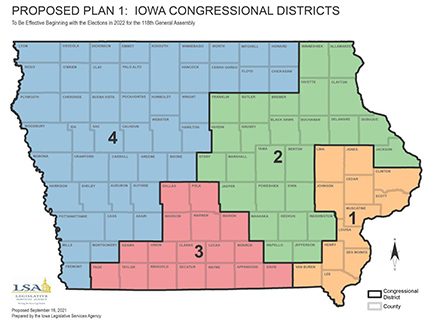An agency will release a second attempt at redrawing Iowa’s congressional and legislative district lines this week, and the response from Republicans could make clear whether they intend to stick with the state’s nonpartisan process or opt for a more partisan approach that favors GOP candidates.
For 40 years, Iowa legislators have ultimately approved maps created by bureaucrats specifically banned from taking partisan sensibilities or candidate preferences into account. As a result, Iowa typically has among the nation’s most competitive congressional races.
But the once-a-decade process allows that if legislators reject two maps drawn by the Legislative Services Agency, lawmakers can create any map they want as long as it abides by rules such as relatively equal population distribution and compact districts. With Republicans holding majorities in both legislative chambers as well as the governorship, the GOP would have complete control of that process.
Republicans already have rejected the first set of maps, and Democrats have become increasingly anxious that if they vote down the second effort during an Oct. 28 special session, it would signal a move to approve maps that could make the GOP even more dominant in the increasingly right-leaning state. The LSA has promised to release the new set of maps this week.
“What we’re really concerned about is this corrosive effect on our democracy,” Iowa Senate Democratic leader Zach Wahls said. “We have really serious concerns about what would happen if we get to a third map and partisan amendments start to get filed.”
Only five states have an independent commission to draw maps — Arizona, California, Colorado, Iowa and Michigan, according to the Brennan Center for Justice. Fifteen states have a politically appointed commission or advisory group to draw them, and in the remaining 30 states the legislature draws the maps.
The Iowa Legislature approved the current process in 1980 after a struggle to approve maps a decade earlier resulted in the Iowa Supreme Court adopting its own plan. Under Iowa’s process, lawmakers can vote to accept or reject the nonpartisan maps but can’t tinker with the lines until the third round — a point only reached in 1981, when lawmakers approved the third maps without changes.
Senate Republican leader Jack Whitver said GOP senators were only following the law when they voted unanimously against the first maps, saying lawmakers wanted to see improvements in the population deviation and compactness of some of the districts. Whitver denied that Republicans simply intended to wait for the third set of maps and redraw them to suit themselves.
“We have a very specific process in Iowa code, including how those districts are drawn and what they look like, so if anyone thinks you could just come in and draw whatever you want, that’s not legal in Iowa,” he said. “It’s following the process of a nonpartisan map, a second nonpartisan map, get to a third map if it happens, but you still can’t throw away Iowa law as far as the requirement of what a district should look like.”
What worries Democrats is that Whitver and other party leaders, including House Speaker Pat Grassley, have been unwilling to say they won’t amend the third set.
Iowa law isn’t specific about requirements on legislators, saying only the third map “shall be subject to amendment in the same manner as other bills.” If Republicans were to stray into gerrymandering it would be challenged in court but it’s not been tested since 1980, so it’s unclear how the Iowa Supreme Court would rule.
The court itself has become considerably more conservative in recent years since Reynolds has named four of the seven justices. Two others were seated by her mentor and Republican predecessor Terry Branstad.
Lawmakers may face some pressure to uphold Iowa’s system, so there is some expectation they will not completely discard that tradition, said Donna Hoffman, a political science professor at the University of Northern Iowa.
“There is a norm essentially that you will take one of the LSA’s maps. Now, in an era in which norms are frequently broken, does that mean anything?” she asked.




